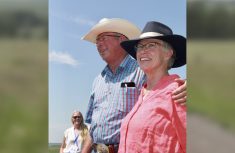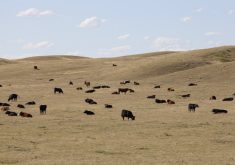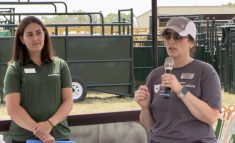Well, that was one for the books. It will be referred to for years to come as the drought of 2021. I “herd” it was a one-in-100-year drought in my area. Hay production was about a quarter of normal. Pastures browned off in July. Dugouts and water sources are dry all over the place. We emptied six water sources this summer here on the ranch watering the livestock. I did get a chance to drive across a good part of the Prairies this summer and the drought was pretty widespread from what I saw.
Read Also

Alberta ranch family outlasts droughts
Over the years, the Lehr family has learned a thing or two about managing the ranch through dry years
Did you know that the “Dirty Thirties” are less than 10 years away? Are you ready for them? On my ranch, water is my most important nutrient, and it is the only nutrient that I manage.
One of the best pieces of advice I have ever received about grazing was from a great mentor of mine, Dennis Wobeser. After the 2002 drought, when all the pastures were burnt off and gone, I asked him, “What do we do now?” He simply stated, “Now we plan for the next drought.” So that is exactly what I have been doing since 2002.
If you are planning for a drought in a drought, you are about 10 years too late. Every year we need to be planning for the next drought. We have been building soil, adding carbon, leaving litter, maintaining a thatch layer ever since 2002. Guess what happened? With only four inches of rain in 2021, (average is 15 in the growing season), the land we have been managing for 15 years or more was hardly affected by the drought. Land that we have been managing for more than 10 years did all right but was set back maybe a third of the production by the drought. Land that we have managed for fewer than five years was about half the production as the previous year. Regenerative grazing gives you drought resilience. It is not drought-proof and it takes time to repair the land.
The problem that we have in agriculture is that the water cycle is generally broken. With a healthy water system, our water bodies will evaporate and the moisture will rise and form clouds. These clouds will then get dense enough to form precipitation and fall back to the ground as rain. Here we need the rain to soak into the soil and infiltrate through the soil to again replenish the water bodies which will again have the moisture evaporate. But this is no longer the norm. Most agricultural land has a broken water cycle.
Let’s look at this broken cycle when it rains on a microscopic level. Without soil armour, (a protective layer of thatch and litter on the surface of the soil), a raindrop hurtles to the ground and impacts the bare soil. It is like a small explosion that destroys the soil structure, breaking apart the aggregates and causing soil capping (the raindrop is tougher than the soil). This leaves a smooth surface that the next raindrop can’t penetrate. It has nowhere to go, so it runs off. As it runs off the land, it takes with it the best parts of the soil, the organic matter.
Without the soil armour, any moisture that did get into the soil is now vulnerable to evaporation. Soil moisture does not work by gravity. It works by diffusion. This is a movement from an area of greater concentration to an area of lesser concentration (wet to dry). If the top layer of the soil’s moisture evaporates due to the sun and wind, the moisture in the lower layer will then move up to the drier area. It will then evaporate, and more moisture will move up. Suddenly our water cycle has been reversed. As this moisture moves up through the soil and evaporates, it can also bring with it unwanted salts that can be detrimental to growth.
So how do we stop this unhealthy cycle? We need to leave more residue and grow the soil. We need to make sure that the first raindrop cannot hit the bare exposed soil. It needs to land on live or dead plant material, as that raindrop will then break apart and soak into the soil without damaging the soil structure (this time, the plants are tougher than the raindrop.)
At this point, we need the organic matter in the soil to hold onto that moisture. It is our job to build water-holding capacity in our soils. Excess moisture will infiltrate the soil and move to larger bodies of water, thus filling them from the bottom and not from runoff. This is a good thing but picture a very sandy soil where all this moisture just slips away. To grow the soil, we have to add carbon to the soil through exudation. This is a job done by the living plants to add liquid carbon to the soil through the root systems. They are feeding the microbiology in exchange for nutrients. They are taking carbon out of the air and adding it to the soil. Sounds like a win-win to me. The more exudation we can promote, the faster we can build soil and increase our water-holding capacity.
The drought of 2021 is now over and what do we do now? We need to maintain soil armour and grow our soil. That is my job. As I said before, water is my most important nutrient and now is the perfect time to start planning for the next drought. It is not the actual rainfall that you receive that is important. It is the effective rainfall that your plants get to use.

















